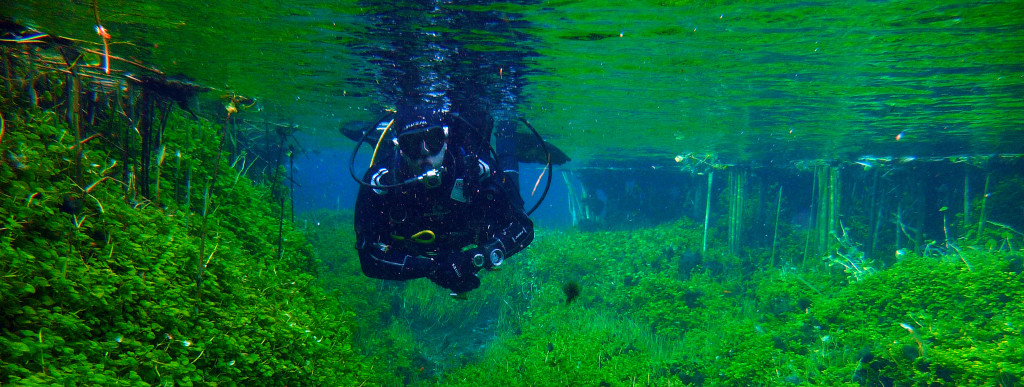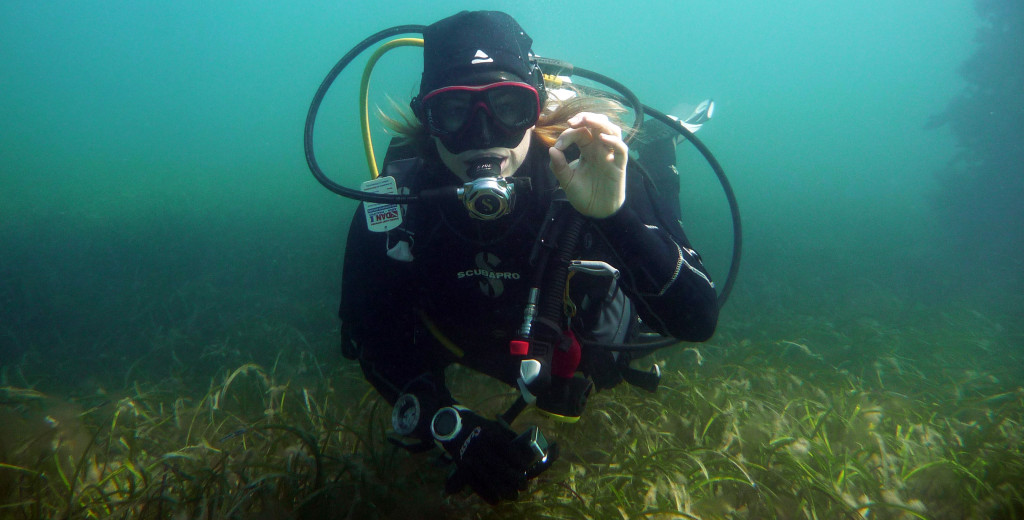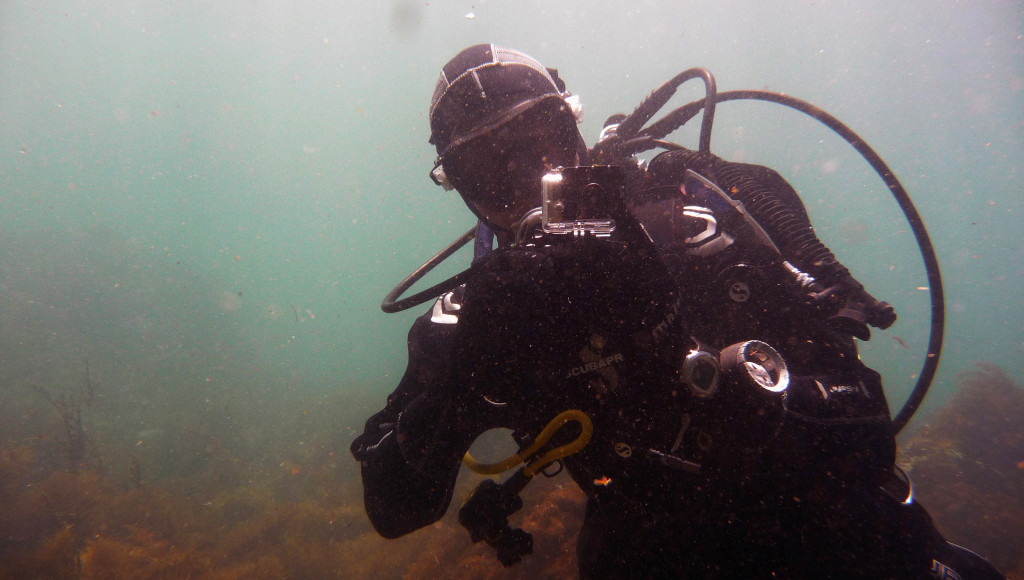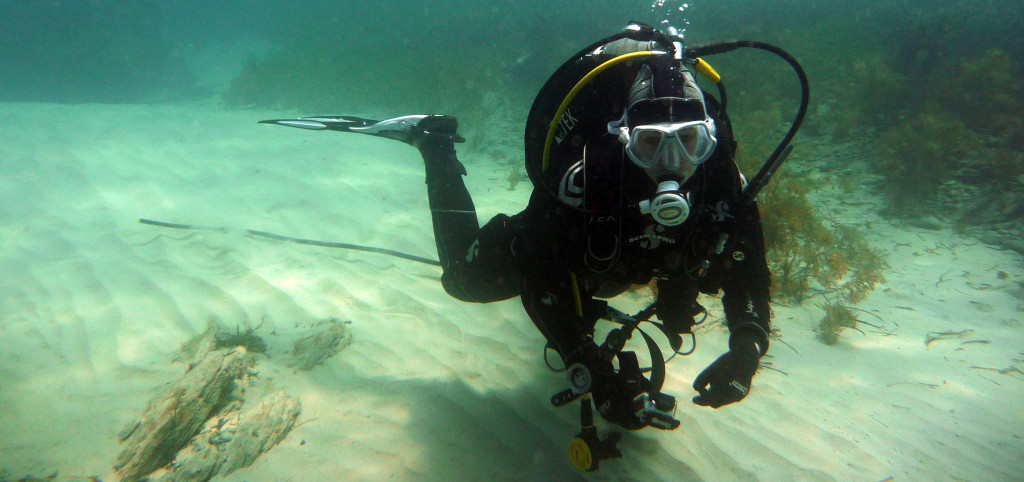Wohoo ~ it’s Winter!! Why are we so happy about that? Read on and find out!!
We’ve received heaps of emails from tourists and locals who want to know what our ‘dive season’ is and what the conditions will be like in South Australia in the Winter months! Many of them are wondering what diving in Winter is like and whether or not it’s better to wait until it’s Spring again and the waters will be warming up again. So we thought it would be a good idea to write down our thoughts in a blog post about the pro’s and con’s of diving in Winter!
First of all: It’s not a myth! The water temperatures drop in Winter and you have to wear a thicker wetsuit and protect your head a bit more in those colder waters! What’s also not a myth is that diving in the colder Winter waters can be much better than diving during the hot Summer months! You may have heard about little things that reduce the visibility in Summer, but that die when the waters get colder? We wanted to know exactly what that was all about, so we asked Janine Baker, our local marine ecologist about this and she told us that the water clarity in Winter increases as there are no phytoplankton blooms that reduce the visibility (these happen mainly during the warmer months). She also told us that as we’ve just had the two hottest Summers on record in SA (since BOM data recording began), this contrast between Winter visibility and Summer visibility is likely to increase further as the trend of hot Summers seems likely to continue.
Another benefit of diving in the colder months is that the car parks and beaches won’t be as crowded as they are in the warmer months. Plus, when diving from jetties, you won’t have to wait for all the snorkellers and jetty jumpers to get in or out of the water!
Are you still a bit worried about the cold?? Then please note that our rental/school wetsuits are the thickest rental suits in Adelaide (7.5mm!!) and that we use those during the scuba diving courses as well. We can also provide extra layers, such as hooded vests, gloves, and separate hoods to make sure you stay as warm and comfortable as possible!
What we recommend for people looking at purchasing their own equipment, is instead of investing in a 7mm or a semidry suit, to invest in a 5mm and a drysuit! The most versatile suit for South Australian diving would obviously be a 7mm or a semidry suit as you can dive in these suits all year round, so if you are only going to invest in one suit, then definitely go for one of these types of suits as they will keep you warm and comfy for most of the year. However, if you don’t mind investing in your own comfort, then think about investing in a 5mm wetsuit and a drysuit and know that you will be supercomfortable all year round!
The way a wetsuit works is that it traps the water between your skin and the wetsuit. As soon as you jump in the water in your wetsuit, your suit fills up with a very small layer of water. Your body heat warms up this small layer and as long as this water stays warm and doesn’t move around too much, you will stay comfortable on your dive. Keep in mind that your core body temperature is about 37 degrees, so when you jump in the water always feels a bit chilly, whether you’re jumping in waters of 24 degrees in Summer or 14 in Winter (of course the difference is a lot bigger in Winter, so the initial shock is a bit bigger then), but your body will heat that thin layer up very quickly and within minutes you should be warm again.
This is the reason why a good fit is so important. A tight wetsuit is obviously not as easy to put on, but because you don’t have any room for the water to move around in a wetsuit that fits you properly and the seals keep out additional water from entering the suit, you will stay warmer for a lot longer! That’s why a semidry suit works so well as well, because the neck seal of these suits seals better than that of normal wetsuits, restricting water from entering the suit and moving around.
Surprisingly, you lose most of your heat through your head, which is why it’s so important to wear a hood or a beanie to protect your head! However, whatever you do, eventually you will cool down enough to get cold (when you’re diving for 100+ minutes in the tropics and you may get cold as well, simply because the 30 degree water around you is still colder than your body temperature of 37 degrees).
Now if you, like us, hate to get cold and want to dive in complete comfort, then the only way to go in South Australian winters is a drysuit. This is what Ron and I and almost all of our team members dive in during the colder months (most of us dive in the Scubapro Everdry 4 neoprene drysuit). These suits don’t let any water in, so instead of warming up a layer of water, the only thing you have to warm up is the air around you, and your body does that a lot quicker than heating up water! Now a lot of people feel like they have to be an advanced diver with a lot of experience before taking the step to a drysuit, but don’t forget that in other parts of the world people do their open water courses in drysuits, so it’s really not that hard to get used to diving in one. Especially if you start in a neoprene one, it’s not much different to diving in a wetsuit and we promise you’ll get used to it within a dive or two.
Every single person we know who made the swap from wet to dry simply couldn’t believe how easy it was and complained that they should have taken the step ages ago! One of our customers who purchased the Scubapro drysuit from us went on a 60 minute dive and came in the next day to let us know that he felt like he could have easily dived for another 60 minutes!
Here at Diving Adelaide we sell all sorts of drysuits, from the easy to use and affordable neoprene drysuits (starting as low as $950 for one of the best neoprene suits on the market!) , to the slightly more advanced trilaminate suits. Simply swing by the shop to have a chat about the different styles and/or try one of the suits on!
So make sure you don’t let the colder waters hold you back from jumping in for a dive or two, as we get some of the best conditions and best visibility of the year in Winter and some very special events (like the cuttlefish migration in Whyalla) plus heaps of other weekends, courses and more – don’t forget to have a look at our calendar ~ :).









